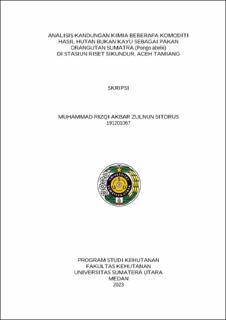| dc.description.abstract | Indonesia is one of the island countries that has considerable natural
resources. In addition to producing timber forest products (TFP), forests also
produce non-timber forest products (NTFP) in the form of fruits, medicinal plants,
resins, and plants such as bamboo, rattan and others. Non-timber products are
widely used by the community as food and livelihoods. NTFPs are also used by
animals that live in the forest as a source of food, one of the animals that use NTFPs
as a source of food is the Sumatran orangutan (Pongo abelii). Food is one of the
important factors in determining the amount of food substances obtained by
animals. The food consumed by animals affects their growth and development. So,
research is needed on phytochemical testing of Sumatran orangutan food with Gas
Chromatography Mass Spectrophotometry (GCMS) instruments so that the
chemical content and quality of food eaten by Sumatran orangutans can be known.
In this research, there were 3 (three) foods that represent orangutan food to be
tested for extracts by GCMS, namely halaban fruit (Vitex pinnata), forest pandanus
fruit (Pandanus sarasinorum) and selupik fruit (Balakata baccata). Before being
tested with GCMS, the three food items used were dried to a constant weight and
mashed into natural dried raw. Then, the natural dried raw was extracted by
maceration method for 3x24 hours. The result of maceration filtrate was further
tested with GCMS instrument. The results showed the presence of 1 compound
found in the three feed extracts, namely n-Hexadecanoic acid (C16H32O2). So, it can
be assumed that the presence of this compound is one of the factors that influence
the preferred food by the Sumatran orangutan (P. abelii). N-hexadecanoic
compounds have antialopecia, antiandrogen, antifibrinolytic, antioxidant, antiinflammatory
and antifungal activities. | en_US |


